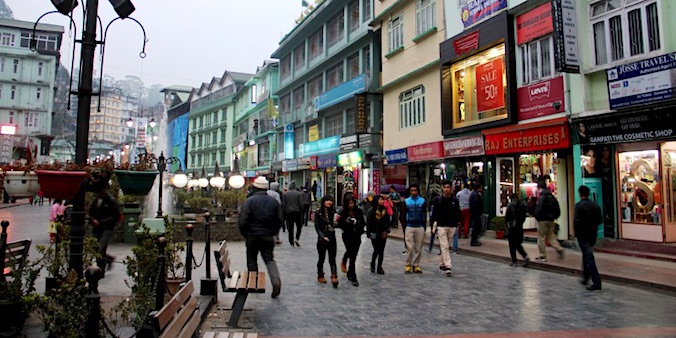Darjeeling, Sikkim & Shingalila Ridge Trek
Tour - 14 days/ 5 days trekking
About Darjeeling & SIKKIM
Sikkim and neighboring Darjeeling have a lot to offer to mountain lovers, aficionados of Buddhist culture and trekkers. Wedged in between Nepal, Bhutan and Tibet – but part of India – this region shares a lot with these areas.
Darjeeling, situated at 2040m, has the typical atmosphere of Indian hill stations. It was the former summer capital of British India, and has preserved much of the old-world charm. Darjeeling is world-famous for its tea, which is grown in extensive tea estates that clad the surrounding slopes. Being very close to the tallest mountains on earth, especially number 3, the Kangchenjunga (8586m) it also boasts great views from most hotel windows.
It’s next-door neighbour Sikkim – of which it used to be part – is a gem of cultural and natural diversity. Until 1974 Sikkim was an independent kingdom, now it is part of India. It is home to different Himalayan peoples, most from Nepali descent or originating from Tibetan and Bhutan, such as the Bhutias who brought Buddhism to the area four centuries ago. Thanks to them Sikkim boasts of colorful Buddhist monasteries and Buddhist festivals. The Lepcha’s, until a few decennia ago forest-dwelling animists, hold a unique culture that the Sikkimese government is trying to preserve.
Read more…Read less…
Region
Darjeeling & Sikkim
(India)
Best Time
March-April &
Oct-Dec
No. Of Days
14 days, 5 days trek
Trip Character
Jeep tour with trek
Sleeping Altitude
1620 - 3636 m
Trek Character
Camping trek
Level: 2
Price
INR XXX/ $ XXX
ABOUT THIS TOUR
On this tour, you’ll fly from Delhi to Bagdogra, south of Sikkim, and then travel to Darjeeling, the tea capital of India endowed with a lot of old world charm.
From here, you’ll travel on foot up the Singalila Ridge, a mountain ridge that marks the border between India and Nepal. Walking for five days over this natural balcony, you’ll be surrounded by beautiful forests of firs and (in spring) blooming rhododendron trees,. You’ll pass through quaint little villages and – weather permitting – get some of the most awesome views in the Himalayas. This can be done as a camping trek as well as a lodge trek.
After this trek you’ll travel on to Sikkim, exploring its ancient monasteries and temples, traditional Bhutia and Lepcha villages, and staying at homestays and family-run ecolodges. The last day, before returning to Bagdogra and flying onward to Delhi, you’ll spend exploring Sikkim’’s quaint but relatively hip capital, Gangtok.
YOUR custom-made TRIP
The tour described here, as well as the other ones on our website, are mainly meant as suggestions. We would be happy to offer you a travel proposal that fully meets your personal demands and expectations. That means that you choose where you want to go, what level of accommodation and type of transport you want and what activities you prefer.
Please let yourself be inspired by this and other trips on our website and then drop us a line (or call us) to explain your travel wishes. We will be happy to help you put together the perfect trip. You can reach us over e-mail, Messenger, Whatsapp or mobile phone.
EXTENSIONS & VARIATIONS
Apart from the tour as described here, you could consider the following add-ons and changes:
- Travel further north – which means: higher – into the Sikkimese Himalayas and explore the isolated ‘Tibetan’ hamlets of Lachung and Lachen.
- Do a more challenging trek instead of the Shingalila Ridge trek. For instance, the Goecha La trek, or the slightly longer Goecha La Trek Plus. On these 10 or 12-day treks you sleep in trekkers tents while a walk-along cook prepares your meals. You walk longer distances, climb higher but the rewards are even better views of the big guys.
- If trekking is not your cup of tea we can show you some of the beautiful mountain forests, off-road villages and majestic views of the Himalayas on day walks.
ITINERARY
-
Day 1: Delhi ✈︎ Bagdogra & drive to Darjeeling (3 h)
The flight to Bagdogra takes less than 2 h and, in clear weather, affords wonderful views of the Himalayas, including Mt. Everest (8848m) and Kangchenjunga (8568m). At the airport our guide and driver await you, and will take you to up to Darjeeling. Altitude 2430m. -
Day 2: In Darjeeling
Early morning you will board to so-called Toy Train, a narrow-gauge coal-fuelled steam train from the old days, upt Ghoom, whether you'll visit the area's oldest Buddhist temple. Later, you can visit the main bazaar of Darjeeling, the very interesting Mountaineering Institute and the Tibetan Refugees Handicraft Centre. Altitude 2430m. -
Day 3: Darjeeling – Rimbik & trekking to Gudrum (4 h driving, 3 - 4 h walking)
A scenic ride brings us to Rimbik, the start of our trek. Along today’s undulating trail we first pass farm houses and witness village life. Then, accompanied by the sounds of birds and cicadas, we enter the forest with rhododendron, magnolias and oaks. Camp is at picturesque Gurdum. Altitude 2430 → 2200 → 2350m. -
Day 4: Gudrum - Sandakphu - (7 - 8 h walking)
This is the most strenuous day of the trekking but also a very enjoyable one! The path climbs uphill through the forest until Sandakphu, with spectacular views of four of the world’s five highest peaks: Everest, Kanchenjunga, Lhotse and Makalu. Because this village can also be reached by jeeps we camp a little further on. Altitude 2350 → 3635. -
Day 5: Sandakphu - Sabargram (6 h walking)
Enjoy breath-taking views of the entire Kanchenjunga Range at sunrise. Today’s relaxed walk along the Singalila Ridge is hard to beat due to the sheer grandness of its views and the vastness of the surrounding landscapes. The trail is lined with rhododendrons, magnolias and wildflowers, which all bloom in spring. Altitude 3635 → 3600m. -
Day 6: Sabargam - Phalut - Sammanden (22km/ approx. 7 h walking)
Both mountains and sunrise are visible from our hilltop camp. First we walk along the ridge till Phalut, followed by a long downhill stretch through the forest and along picturesque Gorkhey to a clearing at Sammanden. Altitude 3600 → 2500m -
Day 7: Sammanden - Shikola - Rimbik (6 - 7 h walking) & car to Darjeeling (4 h drive)
First we descend through the forest, then pass some villages until we reach the valley floor at Srikhola. We continue to Rimbik. Transfer by car to Darjeeling. Altitude 2500 → 2200 → 2430m. -
Day 8: Darjeeling - Rinchenpong (6 h)
Today a scenic drive through wooded slopes, tiny villages will take you to Rinchenpong (2040m) village and check into the historic Yangsum farm, built in 1833 and renovated in 1966. Altitude 2445m. -
Day 9: In Rinchenpong
You can take walks around the farm, visiting a local monastery and the Lepcha Heritage House. The Lepchas are probably the earliest inhabitants of Sikkim, migrating from Southern Bhutan, originally animists, these days often converted to Buddhism. Altitude 2445m. -
Day 10: Rinchenpong - Pelling (44km/ 3-4 h)
Pelling will be your destination of today. On the way, you’ll visit Sikkim’s finest Buddhist monastery, Pemayangtse, built in 1705. It has a beautiful architecture and a rare collection of antiques. Altitude 2445 → 1960m. -
Day 11: in Pelling
Today you can visit the old and impressive Pemayangtse Monastery in Pelling, as well as the nearby monastery of Sanga Choeling and the palace ruins of Randantse. Altitude 1960m. -
Day 12: Pelling - Rumtek (5h)
Today a drive for 5 hours will take you to Rumtek, not far from Sikkim's capital Gangtok. On the way we visit another spectacular monastery, Tashiding Gompa, built in 1641 by a famous sage. Tonight you stay at a very pleasant family-run ecoresort. Altitude 1800 → 1620m. -
Day 13: Rumtek - Gangtok - Rumtek (5h)
The large monastery of Rumtek was constructed in the sixties by the abbot of the Karmapa sect and his followers, who had to flee Tibet in 1559. After visiting this interesting gompa, you can spend the whole day exploring Gangtok, one of India's most sloping cities, mostly on foot. There is a lot to see and visit, not in the last place the many 'hip' restaurants and bars. Altitude 1620 → 1650 → 1620m. -
Day 14: Rumtek - Bagdogra ✈︎ Delhi (4 h drive, 2 h flight)
After breakfast you descend to Bagdogra where you check in for the flight to Delhi. It depends on the timing of your international flight whether you will need an overnight stay in Delhi. In the latter case we can arrange this for you.
HIGHLIGHTS OF THIS TOUR
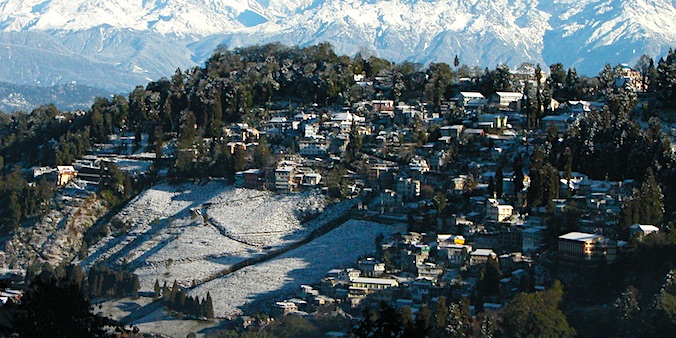
DARJEELING
DARJEELING'S TOY TRAIN
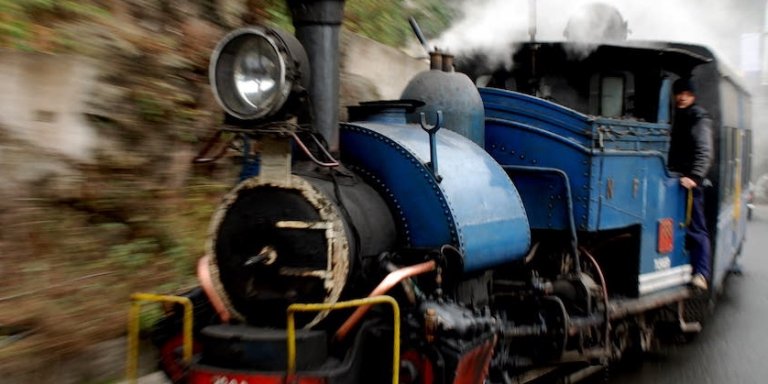

Darjeeling Tea
If there is one legacy of the Brits in India it is tea. Tea estates, tea processing and exporting, and tea drinking. It was long believed that wild tea, Camelia sinensis, only grew in China, but this small woody brush was ‘rediscovered’ by the British in the early 19th century in the jungle of Assam. Camelia sinensis var. assamica had long been used by indigenous people. Large tracts of land were converted into tea gardens and these days Darjeeling (and Assam) tea are known worldwide. There are two kinds of preparation. The black tea that is being dunked in water that just has been boiled is called orthodox. In Indian households and tea stalls the tea is generally boiled for some time with milk and sugar, and sometimes spices. This is called CTC tea. The two kinds of tea require different factory handling, but both have the same Camelia leaves as the starting point.
Singalila Ridge Trek
If we were to pick one trek that is, at best, moderately strenuous while offering superb views of the Himalayan giants, it is the Singalila Ridge Trek. On this trek you climb through well-protected subtropical forests teeming with butterflies, birdlife and some rare species like the red panda up to the montane zone of fir and Rhododendron. From late April to May exuberantly blooming rhododendrons and magnolias set the hill sides on fire. Emerging at the alpine meadows of Sandakphu, you’ll be treated to breathtaking views of the Himalayan range. Especially during autumn (October – December), when you can expect clear skies, you can see five summits higher than 8000m within one sweeping view, amongst them Everest, Kangchenjunga, Makalu and Lhotse.
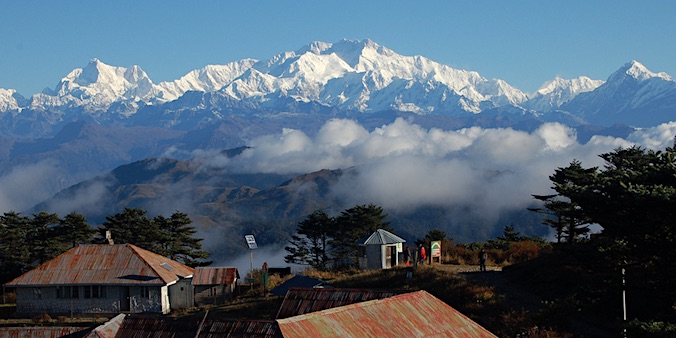
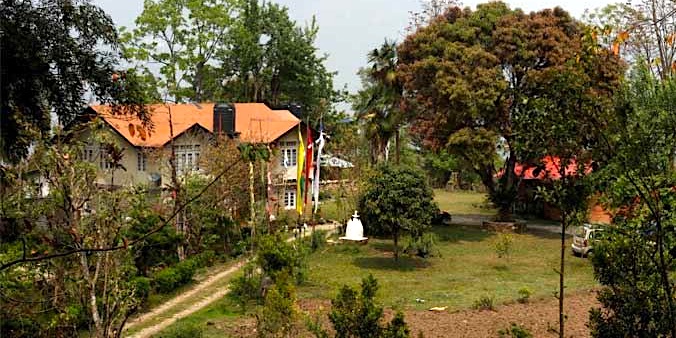
Yangsum Farmhouse
The Lepchas

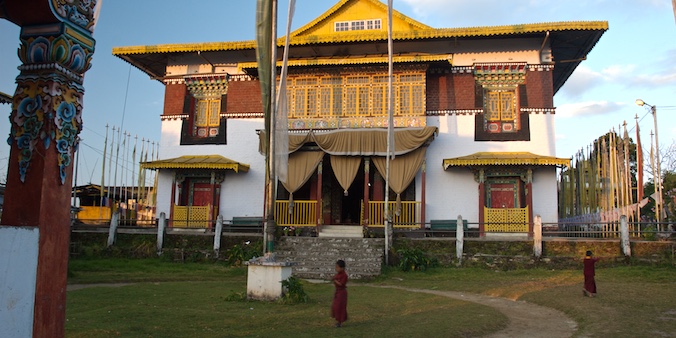
Pemayangtse Monastery
Teen Taley Eco Resort
Teentaley Eco Resort is not a hotel but, as they say “an organic experience of the real, rural Sikkim.” Here, you stay in cozy bamboo cottages amidst a sprawling landscape garden, with a farmhouse and a private forest where you can go bird watching without leaving the premises. The food is home-grown, organic of course, and dinners are accompanied with the typical Sikkimese tongba – bamboo containers filled with millet beer. As the location, in Rumtek, is close to Gangtok, you can stay here, sleeping in the quiet of the mountains and waking to the birds’ songs, while visiting Sikkim’s capital during the day.
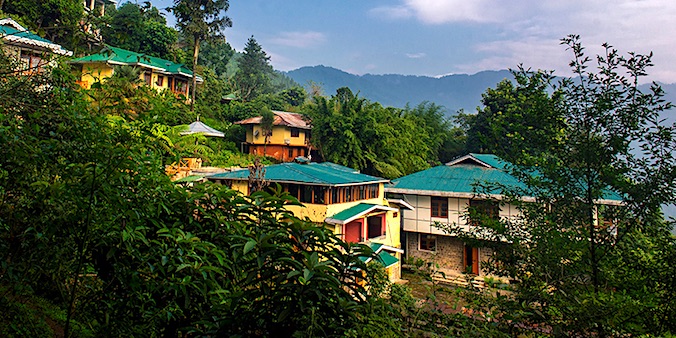
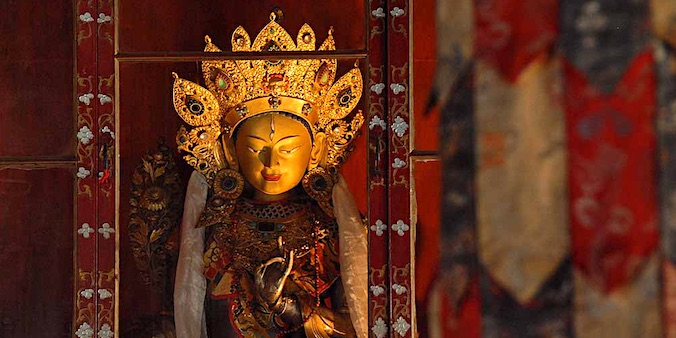
Rumtek Monastery
Gangtok
In Sikkim’s capital Gangtok, the rear neighbours almost always live on another street and hardly anyone has a garden, because the slopes are too steep for that. This also means that the roads are nowhere wide and often clogged. But fortunately most locations in the city can be reached on foot. Pedestrians can use a whole series of footbridges to cross busy roads. Gangtok was also the first city in India to declare its centre a pedestrian area. Here it is pleasant to stroll and shop and there are numerous ‘hip’ restaurants and cafes. Thanks to the government’s serious approach to environmental problems – a rarity in India – this is also one of India’s cleanest city centres. Interesting places to visit include the flower exhibition – with many varieties of orchids, – the Institute of Tibetology, Enchey Gompa and Tashi Viewpoint.
